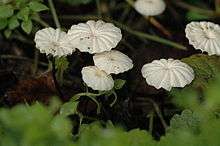Marasmiaceae
| Marasmiaceae | |
|---|---|
 | |
| Marasmius rotula | |
| Scientific classification | |
| Kingdom: | Fungi |
| Division: | Basidiomycota |
| Class: | Agaricomycetes |
| Order: | Agaricales |
| Family: | Marasmiaceae Roze ex Kühner (1980) |
| Type genus | |
| Marasmius Fr. (1835) | |
| Diversity | |
| Over 50 genera, 1500+ species. | |
| Synonyms[1] | |
|
Omphalotaceae Bresinsky 1985 | |
The Marasmiaceae are a family of basidiomycete fungi which have white spores. They mostly have tough stems and the capability of shrivelling up during a dry period and later recovering. The widely consumed edible fungus Lentinula edodes, the shiitake mushroom, is a member of this family. According to a 2008 estimate, the family contains 54 genera and 1590 species.[2]
The family Omphalotaceae, described by A. Bresinsky in 1985[3] as a segregate from the Tricholomataceae, is currently considered synonymous with Marasmiaceae.[1] Genera formerly included in that family (including Anthracophyllum, Gymnopus, Lentinula, Marasmiellus, Mycetinis, Rhodocollybia, Omphalotus) are now classified in the Marasmiaceae.
Genera
Further information: List of Marasmiaceae genera
See also
References
- Kirk PM, Cannon PF, Minter DW, Stalpers JA (2008). Dictionary of the Fungi (10th ed.). Wallingford: CABI. ISBN 978-0-85199-826-8.
| Wikimedia Commons has media related to Marasmiaceae. |
This article is issued from Wikipedia - version of the 5/20/2016. The text is available under the Creative Commons Attribution/Share Alike but additional terms may apply for the media files.